boot Peugeot 508 RXH 2012 Owner's Manual
[x] Cancel search | Manufacturer: PEUGEOT, Model Year: 2012, Model line: 508 RXH, Model: Peugeot 508 RXH 2012Pages: 302, PDF Size: 9.33 MB
Page 4 of 302

.
.
Contents
Instrument panel 45
Indicator and warning lamps 46
Gauges and indicators 57
Tr ip computer 62
Instruments and controlsFamiliarisation
Remote control key 65
Alarm 74
El
ectric windows 76
Boot 78
Motorised tailgate 79
Panoramic sunroof 82
Fuel tank 83
Diesel misfuel prevention 84
Access
Front seats 86
Rear seats 90
Mirrors 92
Steering wheel adjustment 94
Interior fi ttings 95
Boot fi ttings 98
Heating and Ventilation 104
Manual air conditioning 106
Dual-zone digital air conditioning 108
Quad-zone digital air conditioning 111
Rear screen demist - defrost 116
Programmable Heating/Ventilation 117
Comfort
Electric parking brake 118
6-speed electronic gearbox system 125
Hill start assist 129
Head-up display 130
Speed limiter 133
Cruise control 135
Parking sensors 137
Parking space sensors 139
Driving
Lighting controls 141
LED lamps 144
Automatic illumination of headlamps 146
Headlamp adjustment 149
Directional lighting 150
Wiper controls 151
Automatic rain sensitive wipers 153
Cour tesy lamps 155
Interior mood lighting 156
Visibility Hybrid system
Presentation 22
Starting/switching off your vehicle 25
Ready lamp 29
HYbrid4 mode selector 29
Energy consumption/generation indicator 32
Display of hybrid power fl ow 33
Eco off 36
Eco-driving 37
Consumption 39
High voltage battery 40
Vehicle recovery 44
Page 12 of 302
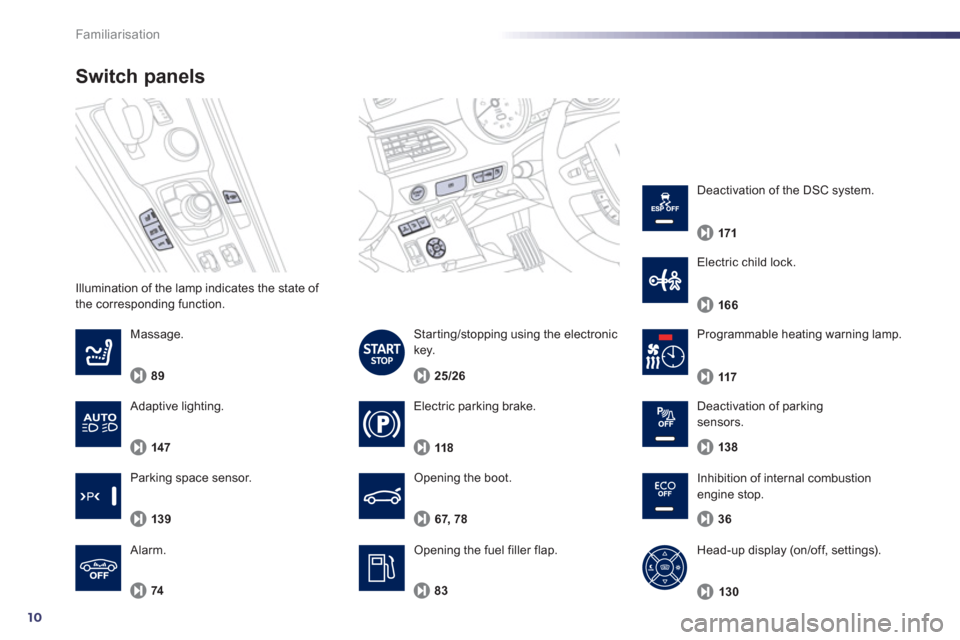
10
Familiarisation
Illumination of the lamp indicates the state of
the corresponding function.
Switch panels
Opening the boot.
Opening the fuel filler flap. 67, 7
8
Massage.
89
74
Alarm.
Pro
grammable heating warning lamp.
83
117
Electric parking brake.
11
8
Starting/stopping using the electronic
key.
25/26
Inhibition of internal combustion engine stop.
3
6
Head-up display (on/off, settings).
13
0
Deactivation of parkingsensors.
138
Parkin
g space sensor.
139
Electric child lock.
166
Deactivation of the DSC system.
171
Adaptive lighting.
147
Page 25 of 302
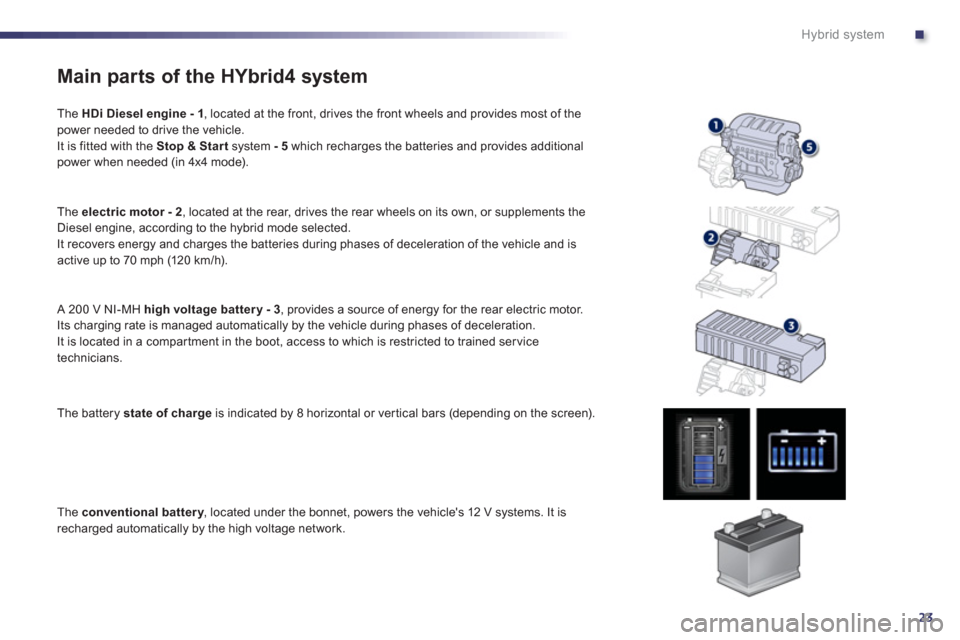
.
23
Hybrid system
Main parts of the HYbrid4 system
The HDi Diesel engine - 1
, located at the front, drives the front wheels and provides most of the power needed to drive the vehicle.
It is fitted with the Stop & Start
system - 5
which recharges the batteries and provides additional
power when needed (in 4x4 mode).
Th
e electric motor - 2
, located at the rear, drives the rear wheels on its own, or supplements the
Diesel engine, according to the hybrid mode selected.
It recovers energy and charges the batteries during phases of deceleration of the vehicle and is
active up to 70 mph (120 km / h).
A 200 V NI-MH high voltage battery - 3
, provides a source of energy for the rear electric motor.
Its charging rate is managed automatically by the vehicle during phases of deceleration.
It is located in a compar tment in the boot, access to which is restricted to trained service
technicians.
The batter
y state of chargeis indicated by 8 horizontal or vertical bars (depending on the screen).
The conventional battery, located under the bonnet, powers the vehicle's 12 V systems. It is yrecharged automatically by the high voltage network.
Page 40 of 302
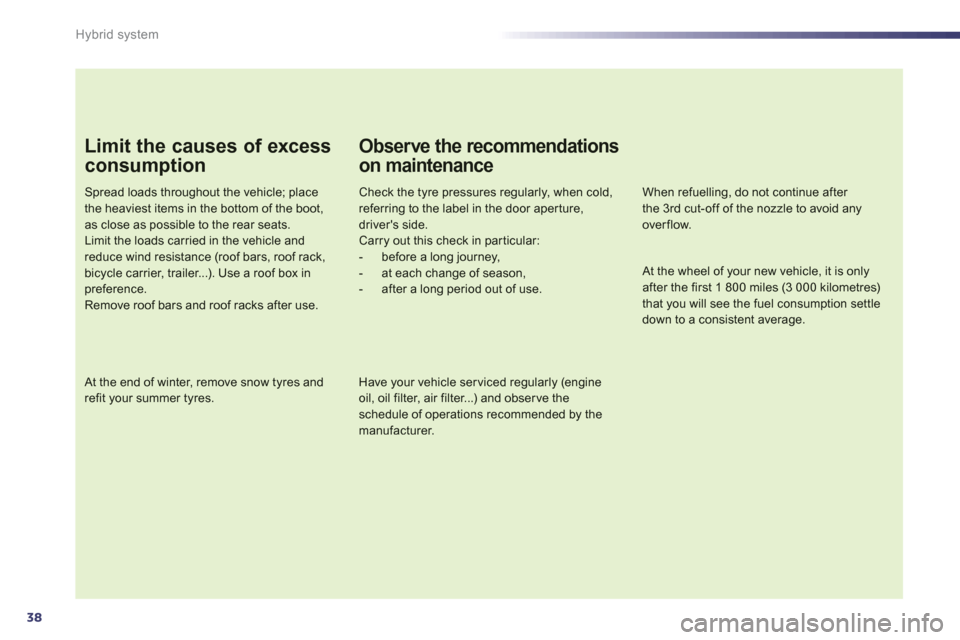
38
Hybrid system
Limit the causes of excess
consumption
Spread loads throughout the vehicle; placethe heaviest items in the bottom of the boot,as close as possible to the rear seats.Limit the loads carried in the vehicle andreduce wind resistance (roof bars, roof rack,bicycle carrier, trailer...). Use a roof box in preference.Remove roof bars and roof racks after use.
At the end of winter, remove snow tyres and refit your summer tyres.
Observe the recommendations
on maintenance
Check the tyre pressures regularly, when cold, referring to the label in the door aper ture, driver's side. Carry out this check in par ticular:
- before a long journey,
- at each change of season,
- after a long period out of use.
Have your vehicle ser viced regularly (engine oil, oil filter, air filter...) and obser ve the schedule of operations recommended by the
manufacturer.
When refuelling, do not continue after the 3rd
cut-off of the nozzle to avoid any overflow.
At the wheel of your new vehicle, it is onlyafter the first 1 800 miles (3 000 kilometres) that you will see the fuel consumption settle down to a consistent average.
Page 42 of 302
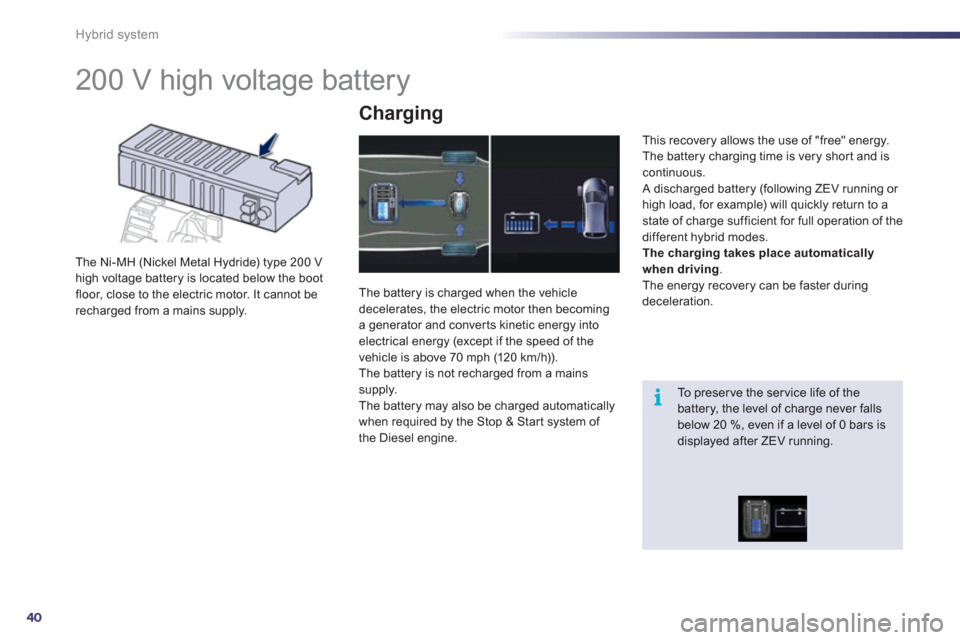
40
i
Hybrid system
200 V high voltage battery
The Ni-MH (Nickel Metal Hydride) type 200 Vhigh voltage battery is located below the boot floor, close to the electric motor. It cannot berecharged from a mains supply.
Charging
The battery is charged when the vehicledecelerates, the electric motor then becoming
a generator and converts kinetic energy intoelectrical energy (except if the speed of the
vehicle is above 70 mph (120 km/h)).
The battery is not recharged from a mains
supply.
The battery may also be charged automatically
when required by the Stop & Star t system of
the Diesel engine.
This recover
y allows the use of "free" energy.
The battery charging time is very shor t and is
continuous.
A discharged battery (following ZEV running or high load, for example) will quickly return to astate of charge sufficient for full operation of the
different hybrid modes.
Thecharging takes place automatically
when driving. The energy recovery can be faster during deceleration.
To preser ve the ser vice life of the battery, the level of charge never falls below 20 %, even if a level of 0 bars is displayed after ZEV running.
Page 44 of 302

42
!
Hybrid system
Fan cooling of the high voltage battery
The high voltage battery has an air coolingsystem, comprising an air intake (located on
the rear shelf) and a fan (located behind the
boot trim).
This s
ystem does not work continuously,
but adapts the force of the fan cooling to the requirements of the battery.
Its operation can be heard at the rear, even if
the vehicle is stopped after a run.
If the air intake is blocked, the battery may
overheat, damaging the battery and causing a
loss of performance of the hybrid system.
For the best use of the high voltage battery, please follow these recommendations: - do not obstruct the air intake withloose articles, otherwise, thebattery may overheat, causing a loss of performance of the hybrid system,- do not spill fluids, as this may causedamage to the battery.
Page 48 of 302
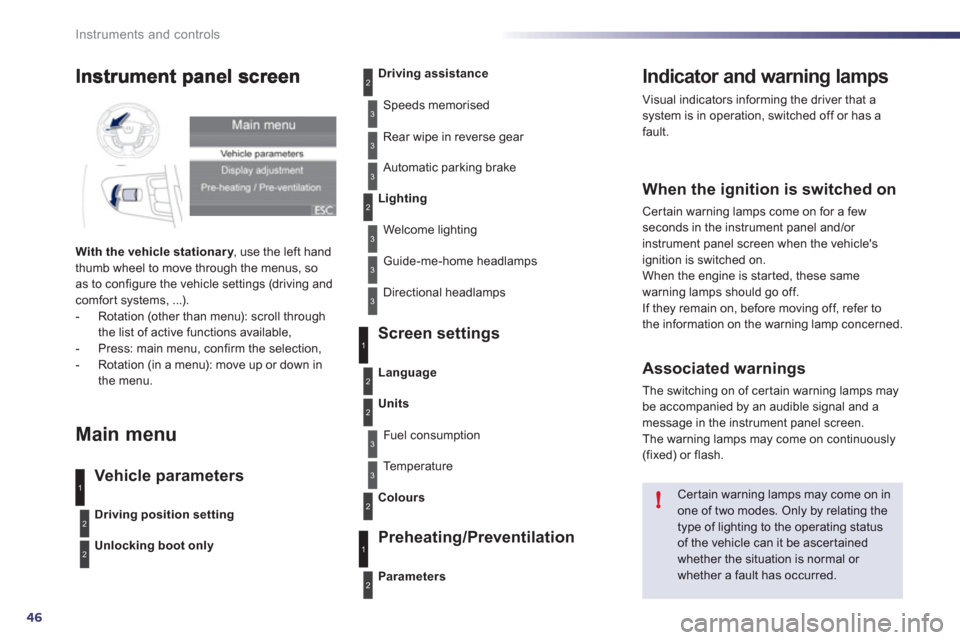
46
!
Instruments and controls
Indicator and warning lamps
Visual indicators informing the driver that a system is in operation, switched off or has a fault.
When the ignition is switched on
Certain warning lamps come on for a few seconds in the instrument panel and/or
instrument panel screen when the vehicle's
ignition is switched on.
When the engine is started, these same
warning lamps should go off.
If they remain on, before moving off, refer to
the information on the warning lamp concerned.
Associated warnings
The switching on of cer tain warning lamps maybe accompanied by an audible signal and a message in the instrument panel screen.
The warning lamps may come on continuously(fixed) or flash.
Certain warning lamps may come on inone of two modes. Only by relating thetype of lighting to the operating status
of the vehicle can it be ascertainedwhether the situation is normal or whether a fault has occurred.
1
2
2
2
3
3
3
2
3
3
With the vehicle stationar y
, use the left handythumb wheel to move through the menus, so as to configure the vehicle settings (driving andcomfort systems, ...).
- Rotation (other than menu): scroll through
the list of active functions available,
- Press: main menu, confirm the selection,
- Rotation (in a menu): move up or down in
the menu.
Main menu
Vehicle parameters Screen settin
gs
Preheatin
g/Preventilation
Driving position setting
Unlocking boot only
Driving assistance
Speeds memorised
Rear wipe in reverse
gear
Automatic parkin
g brake
Lighting
Welcome lighting
Guide-me-home headlamps
Directional headlamps
Parameters
Language
Units
Fuel consumption
Te m p e r a t u r e
Colours
3
1
2
2
3
2
3
1
2
Page 54 of 302

52
Instruments and controls
Serviceon temporarily. A minor fault has occurred for which
there is no specific warning lamp. Identify the fault by reading the message shown on
the screen, such as, for example:
- the h
ybrid system,
- the closin
g of the doors, boot or bonnet,
- the engine oil level,
- the screenwash level,
- the remote control battery,
- saturation of the par ticle emission filter (Diesel).
For any other faults, contact a PEUGEOT dealer or a
qualified workshop.
fixed. A major fault has occurred for which
there is no specific warning lamp. Identify the fault by reading the message shown on the screen and contact a PEUGEOT dealer or aqualified workshop.
(PEF: par ticle emissions filter,Diesel)
fixed, associated
temporarily with a message on the risk of
FEP filter blockage.Thi
s indicates the start of saturation
of the par ticle emissions filter. As soon as traffic conditions permit, regenerate the
filter by by driving at a speed of of least 36 mph(60 km/h) until the ser vice warning lamp goes off.
fix
ed.This indicates the low level of theDiesel additive reservoir. Have it topped up as soon as possible by a PEUGEOT
dealer or a qualified workshop.
Warning/indicator lampStateCauseAction/Observations
Page 57 of 302

1
55
Instruments and controls
Warning or indicator lamp in the instrument panelStateCauseAction/Observations
Engine oilpressure
fixed. There is a fault with the engine
lubrication system. You must stop as soon it is safe to do so.
Park, switch off the ignition and contact a PEUGEOT
dealer or a qualified workshop.
Battery charge
fixed. The battery charging circuit has a
fault (dirty or loose terminals, slack or
cut alternator belt,...). The warnin
g lamp should go off when the engine is started.
I
f it does not go off, contact a PEUGEOT dealer or a qualified workshop.
Door(s) open
fixed, associated with
a message identifying
the door, if the speed is
below 6 mph (10 km/h).
A door or the boot is still open. Close the door or boot.
fixed, associated with a
message identifying the
door, and accompanied
b
y an audible signal
if the speed is above
6 mph (10 km/h).
Page 67 of 302
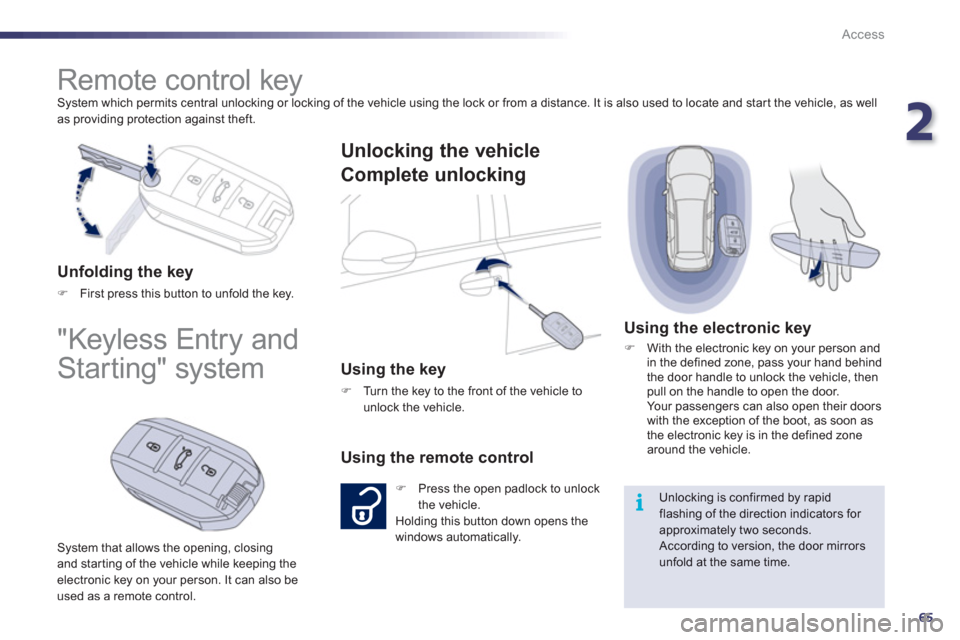
2
65
i
Access
System which permits central unlocking or locking of the vehicle using the lock or from a distance. It is also used to locate and start the vehicle, as well
as providing protection against theft.
Remote control key
Unfolding the key
�)First press this button to unfold the key.
"Keyless Entry and
Starting" system
System that allows the opening, closingand star ting of the vehicle while keeping theelectronic key on your person. It can also be
used as a remote control.
Unlocking the vehicle
Complete unlockin
g
Using the key
�) Turn the key to the front of the vehicle tounlock the vehicle.
Using the remote control
�)
Press the open padlock to unlock
the vehicle.
Holding this button down opens the
windows automatically.
Using the electronic key
�)
With the electronic key on your person and
in the defined zone, pass your hand behind
the door handle to unlock the vehicle, then
pull on the handle to open the door.
Yo u r p a s s e ngers can also open their doors
with the exception of the boot, as soon as
the electronic ke
y is in the defined zone around the vehicle.
Unlocking is confirmed by rapidflashing of the direction indicators for approximately two seconds.
According to version, the door mirrorsunfold at the same time.